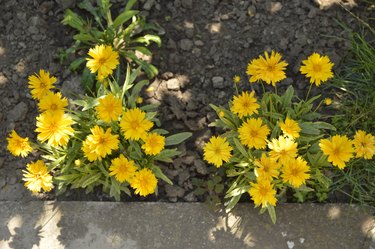
The coreopsis (Coreopsis spp.) is a herbaceous perennial that is often grown as an annual. These low-maintenance flowering plants belong to the daisy family. Pruning coreopsis in the spring is sometimes necessary if the spent flowers from the previous season were left on the plants. However, these plants should also be cut back in the summer. Native to the prairies of North America, coreopsis plants are hardy in U.S. Department of Agriculture plant hardiness zones 3 to 9.
Types of Coreopsis Plants
Video of the Day
There are various species of coreopsis, which are known as tickseed. The majority of tickseed plants have yellow, single, daisylike flowers. The greater tickseed (Coreopsis major) has 2-inch flowers with yellow petals and yellow centers. The blooms of the large-flowered tickseed (Coreopsis grandiflora) are 2 to 3 inches wide and feature yellow petals around a darker yellow center. The lanceleaf tickseed (Coreopsis lanceolata) is similar in appearance to the large-flowered variety. However, although it lasts longer than the large-flowered tickseed, the lackleaf tickseed typically produces fewer blooms.
Video of the Day
Other coreopsis varieties to consider for your garden include the plains coreopsis (Coreopsis tinctoria), a species that can be identified by its reddish-brown center disks, and the tall tickseed (Coreopsis tripteris), which has a dark center that makes this species reminiscent of black-eyed Susans. If you want to plant coreopsis but desire an alternative to yellow, consider the pink threadleaf coreopsis, one of the hardiest varieties, which has pink flowers that are usually less than an inch in diameter.
Pruning Coreopsis in Spring
Coreopsis plants may be cut back at different times of the year for different purposes. In the summertime, you can cut back your coreopsis in order to encourage rebloom in the fall and also to tame unwieldy foliage growth. Deadheading the plants to remove spent flowers can also stimulate an autumn bloom. Deadheading regularly is necessary to prevent the plants from reseeding aggressively like many coreopsis are capable of doing.
However, after the fall bloom, you may opt to allow the dry flowers to remain on the coreopsis plants during the winter months for ornamental value. You can also leave the dry foliage on the plant at this time. If this is the case, you will want to prune coreopsis in the spring, removing the spent flowers and cleaning up the foliage before new growth is ready to begin.
Caring for Coreopsis
Coreopsis plants grow best in full sun, which means that they should receive at least six hours of sunlight a day. Most coreopsis plants can survive in soil that is on the dry side. In fact, coreopsis are known to thrive even in rocky soils. A notable exception is the pink threadleaf coreopsis, which must be kept moist. However, good drainage is required with all coreopsis in order to prevent crown and root rot.
Coreopsis are most easily grown as annuals. However, clumping and rhizomatous species can also be kept as perennials. In this case, you will need to divide the coreopsis plants every two to three years. Failure to divide coreopsis can reduce the life span of the plant.